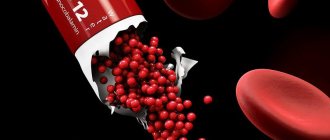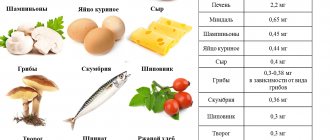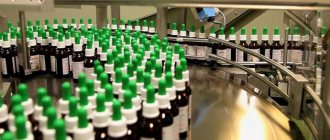What is vitamin A good for and why does the body need it?
The role of vitamin A in the human body is difficult to overestimate. It is involved in the preservation of immunity, acts as an antioxidant, is necessary for vision, and participates in redox processes. Plays an important role in metabolism and in the structure of bone tissue, teeth and hair, improves metabolism.
By supporting immune T cells, vitamin A fights tumors and slows down cellular aging, allowing you to look younger. It also improves the growth of the embryo, is responsible for the concentration of cholesterol in the blood and is involved in the synthesis of steroid hormones. This list of positive qualities does not allow us to question the benefits of vitamin A.
Why is vitamin A deficiency dangerous in the body?
Manifestations of retinol deficiency in the body depend on the degree of deficiency and the stage of the disease. The clinical picture of hypovitaminosis A fits into the following 3 stages:
- first stage: this stage is characterized by disturbances and malfunctions in the functioning of some internal organs;
- second stage: disorders affect the immune system;
- third stage: the body’s ability to absorb retinol is impaired.
At the first stage, there are no clear manifestations associated with system violations. At this stage, a person feels tired, increased fatigue, decreased vitality, and an increase in diseases; the symptoms are not specific. Vitamin A deficiency in the body at the primary stage can only be diagnosed using laboratory tests.
The most characteristic manifestation of the second stage is the appearance of diseases associated with weakened immunity. A sharp weakening of the body's immune defense should lead to the assumption of a lack of retinol.
At the third stage, diseases associated with immunodeficiency, visual impairment, skin pathologies, and a negative reaction from the nervous system in the form of sleep disturbances, increased fatigue, asthenic syndrome, and psychological disorders develop. The appearance of inflammatory foci provoked by saprophytes is possible.
Vitamin A deficiency causes vision problems, especially at dusk.
Some symptoms that may suggest hypovitaminosis A:
- rapid skin aging, premature appearance of wrinkles, dandruff;
- dry skin;
- predisposition to acne;
- fragility of nail plates;
- decreased twilight and night vision (night blindness);
- deterioration of teeth;
- sleep disturbance in the form of insomnia, intermittent sleep, disruption of the process of falling asleep;
- excessively rapid fatigue;
- subjective feeling of fatigue;
- psychological disorders in the form of a tendency to apathy;
- reproductive dysfunction;
- infectious foci in the intestines;
- development of cystic lesions of internal organs.
In the case of severe or prolonged retinol deficiency, the situation worsens: there is keratinization of the cornea, pain in the eyes in bright light, necrotic softening of the corneal tissue, leading to irreversible blindness.
A pronounced decrease in immunity can lead to the following diseases:
- common intestinal infections that are difficult to treat;
- bronchitis, sinusitis and pneumonia;
- purulent encephalitis;
- cystic liver disease.
The role of severe retinol deficiency in the development of pancreatic and lung cancer cannot be ruled out. Features of its deficiency in the children's body are a slowdown in growth rates and a high probability of developing color blindness. In adolescents, as a result of a lack of this biologically active substance, delayed sexual and mental development occurs.
Lack of vitamin A in the female body leads to the development of mastopathy and cervical erosion. In men - to erectile dysfunction and libido.
Experts recommend seeking help as soon as the first symptoms appear that could indicate a retinol deficiency. An examination will help clarify the diagnosis. Timely treatment will allow you to avoid severe stages of hypovitaminosis and the occurrence of dangerous conditions.
What causes the shortage
In the bodies of healthy people, in the case of a properly selected balanced diet, the likelihood of vitamin A deficiency is quite small. Newborns and young infants receive sufficient amounts from breast milk or adapted formulas. Representatives of older age groups eat from various products included in their daily diet.
The following factors can lead to a decrease in this biologically active substance in the body:
- a diet containing an insufficient amount of foods rich in retinol or carotene (in particular, reducing the amount of milk, vegetables and fruits, eggs, butter, liver, fats in the diet);
- parenteral nutrition, especially low in fats and proteins (proteins are responsible for the transport of vitamin A);
- diseases characterized by a decrease in the ability of retinol to be absorbed in the intestine (celiac disease, celiac disease, cholecystitis, spastic colitis, Crohn's disease, pathology of the pancreas and liver, anemia, alcoholism, a common form of tuberculosis, long-term use of mineral oils);
- excessively high levels of vitamin A loss in certain pathologies (oncological diseases, chronic infectious and inflammatory processes, diseases of the urinary system);
- excessively high consumption of vitamin A (conditions that contribute to this: a period of rapid growth and development, pregnancy, lactation, increased mental and physical stress, stress, especially prolonged).
The primary form of retinol deficiency is rare. This condition is mainly secondary - it occurs as a result of one or another pathology.
Vitamins of group A
The group of retinoids, based on their origin, is usually divided into two forms: retinol, found in products of animal origin, and carotene, found in plant products, this is a precursor of retinol. The importance of vitamin A for the body is difficult to overestimate, knowing how it affects the human body.
It primarily affects vision, being part of the visual pigment, which is responsible for the light and color perception of the eye. Prevents damage to cellular DNA, maintains cell integrity, improves tissue healing and is involved in the formation of red blood cells. In addition, it increases the number of leukocytes - the main defenders of the human body, improves immunity, reducing the risk of infectious diseases by 2-3 times.
Vitamin A is found in some cosmetics. Retinoic acid can stimulate the production of collagen in the skin, which is responsible for elasticity and youth. For men and women, the compound is useful because it affects the synthesis of sex hormones - testosterone and estrogen, and therefore participates in the maturation of germ cells.
A valuable quality of beta-carotene is the neutralization of free radicals, which is used for the prevention and treatment of cancer.
Vitamin A norm
The daily dose of vitamin A directly depends on your age. Thus, it is recommended that infants receive approximately 400 mcg of this nutrient from food daily, children from one to ten years old - an average of 450 mcg, the daily requirement of vitamin A for men is 1000 mcg, and for women - 800 mcg.
I remind you that vitamin A during pregnancy and while breastfeeding should be taken in increased doses - from 1000 to 1200 mcg per day.
I hope that after studying my article you were able to fully appreciate the importance of vitamin A for our health. Tell me, have you ever experienced a shortage or excess of it? How did you deal with this problem?
List and table of products
The table will help you figure out which products contain the group of retinoids.
| Retinol (found in animal products) | mg/100 g | Carotene (found in plant foods) | mg/100 g |
| Cod liver fish oil capsules | 30 | Carrot | 10 |
| Turkey liver | 22,6 | Spinach | 5,6 |
| Beef liver | 9,5 | Parsley | 5 |
| Lamb liver | 7,5 | Basil | 3 |
| Chicken liver | 4,2 | Pumpkin | 3,1 |
| Butter | 0,67 | Apricots and peaches | 1 |
| Cream | 0,42 | Cherry | 0,77 |
| Cheese | 0,26 | Peas | 0,63 |
| Egg | 0,19 | ||
| Sour cream | 0,04 | ||
| Cottage cheese | 0,04 | ||
| Milk | 0,02 |
The human body should receive 1/3 retinol and 2/3 beta-carotene, since the activity of the former is 3 times higher than the activity of the latter. This means that you need to include a large amount of vegetables and fruits in bright red, yellow and orange colors in your daily diet.
Sources of Vitamin A
Foods rich in vitamin A are not difficult to find, especially if you are a vegetarian. Vegetables and fruits contain it in sufficient quantities, and therefore plant foods make it possible to qualitatively replenish retinol reserves in the body.
Pumpkin is a worthy competitor to carrots in terms of vitamin A content
Vitamin A in vegetables: carrots, pumpkin, tomatoes, beets, Jerusalem artichoke, potatoes, sweet potatoes. Did you know that orange and yellow-orange-colored products hold the record for the amount of retinol? After all, it is its predecessor carotene, which is a plant pigment, that gives these vegetables such a cheerful color.
However, do not neglect garlic, which contains 2.4 mg of this substance per 100 g of weight
The same goes for the color of fruits, so look for natural vitamin A in persimmons, medlars, melons, apricots, oranges, grapefruits and tangerines. It is also found in viburnum, rose hips, sea buckthorn, and rowan.
Vitamin A is also found in products from the bottom of the sea - algae and seaweed, although there is not too much of it - from 0.1 to 0.2 mg per 100 g.
Kelp added to a salad will replenish your retinol reserves. By the way, these dried seaweed can be used as a useful analogue of salt. If you have switched to a raw food diet or are just striving for live nutrition, try seasoning your dishes with kelp powder. This will make them saltier.
There is also natural vitamin A in foods made from cow's milk, although they are not high in this nutrient. Lactovegetarians will find it in cheeses, sour cream, cream, full-fat whole milk and butter.
You have learned which foods contain vitamin A, which will help you replenish retinol in your body. And now I want to tell you a few important rules that will allow you to best understand it.
Back to contents
Top 10 foods with the highest content
Retinol takes part in the functioning of cells in the human body, and carotenoids must first be converted from plant foods into a biodigestible form. To get 1 unit of retinol, you need to process 3 units of carotenes. Therefore, to obtain the daily requirement of vitamin A, it is more advisable to eat a piece of beef liver than several kilograms of peaches. This means that in the list of products containing vitamin A, the main places belong to products of animal origin.
Of all the foods that contain vitamin A, the liver contains the most of it. It can be consumed in the form of various dishes or purchased dried in capsules.
- 1st place - fermented cod liver oil or cod liver itself (cooked, a lot and canned);
- 2 - beef, lamb or chicken liver;
- 3 - chicken yolks;
- 4 - butter and cream;
- 5 - carrots (the leader in carotene content among vegetables);
- 6 - red rowan;
- 7 - parsley and dill;
- 8 - spinach and celery;
- 9 - dried apricots;
- 10th place - rose hips and sorrel.
Instead of eating vegetables and fruits, you can drink freshly prepared juice from them, which will also have a beneficial effect on your health.
What is vitamin A?
I think it is important to note that the term “vitamin A” hides a whole group of fat-soluble substances with similar properties and structure. These are: retinol (aka A1, askerophthol), dehydroretinol (aka A2), retinal (or retinene), retinolic acid (A-acid). Moreover, this community includes all types and forms of the listed nutrients - esters and isomers.
I don’t know whether this information with complex names will be useful to you, but for general development, perhaps, it will not be superfluous.
It is important to remember that vitamin A is often called retinol. These words are considered synonyms
This substance exists in two forms - this is, in fact, vitamin A itself and its provitamin carotene (the most active form is beta-carotene), which is transformed in our body into A.
They were discovered one after another. But retinol, as you know, comes first. In 1913, this was done by two groups of scientists working independently of each other. Researchers have established a clear relationship between the growth of living creatures, as well as the presence of chicken yolks and butter in their diet.
So from these products an active substance was isolated, which was later called “fat-soluble factor A”, and a little later, in 1916, “vitamin A”. Over time, carotenoids were found in plant foods - the same provitamins (including beta-carotene), which under certain conditions become valuable retinol in our body.
Store vitamin A in your body
Like other fat-soluble substances, A has the valuable property of being accumulated in the body and used by it as needed. Keep in mind that it is involved in many of our internal processes, so please take care of the quality replenishment of your retinol reserves.
What is the best way to do this? Eat foods containing vitamin A. Where to look for it?
Back to contents
Drugs in the pharmacy, list and instructions for use
If an insufficient amount of carotene and retinol enters the body with food, you need to take them in the form of medications. Today there is a wide range of them in pharmacies, and the choice depends on the preferences of the buyer himself.
Vitamin A is produced:
- in capsule form: retinol acetate 3300, 5000, 33000 IU; etretinate (tigazon) 0.01 and 0.025 g; isotretinoin (Roaccutane) 2.5, 5, 10 and 20 mg;
- in the form of tablets of 33,000 IU (retinol acetate and retinol palmitate);
- in the form of a solution for injection in ampoules of 25,000, 50,000, 100,000 IU/1 ml (retinol acetate);
- in dragees 3300 IU (retinol acetate and retinol palminate);
- in an oil solution for oral administration, 100,000 IU/ml in 10 ml bottles;
- in oil extract from cod fish liver in bottles of 50 and 100 mg;
- in the form of a cream 0.05% or 0.1% in tubes of 20 g.
In the pharmacy you can find the following names of vitamin complexes containing retinol: Aevit, Gendevit, Undevit, Aquital and various multivitamin preparations - Centrum, Complivit, Revit, Alphabet, etc.
To get a therapeutic effect from retinoids and avoid overdose, you need to know how to take vitamin A correctly. The dose depends on age and gender.
Retinol in tablets, dragees or capsules is recommended to be taken from 3 to 5 pieces per day after meals. The oil solution is used as follows: 5-10 drops per piece of black bread after meals 2-3 times a day.
An oil solution of vitamin A is administered intramuscularly, taking into account the nature of the disease, warmed to body temperature: adults - 10,000-100,000 IU, children - 5,000-10,000 IU.
To treat burns, wounds or ulcers, an oil solution is used in the form of compresses, which are applied to the affected area 5-6 times a day.
For long-term treatment of eye diseases, injections are alternated with oral retinol.
Pregnant women and children should take medications with caution.
Some factors require increased or decreased retinoid intake. Thus, people who are on a diet and do not get enough fat need additional vitamin A supplements. Diseases of the liver, intestines, and gall bladder lead to a lack of retinol in the body. While the use of oral contraceptives and hormonal drugs, on the contrary, reduces the need for it.
Table of vitamin A content in foods
Research into the vitamin A content of individual foods began immediately after its benefits to the body were determined. The retinol content of animal sources depends on whether the substance was present in the diet of the animal itself.
An example is the difference in the content of this biologically active substance in butter and fish oil: fish feed on plant plankton containing high concentrations of vitamin A, therefore the content of this substance in fish oil is significantly higher than in butter. Foods from the following list contain a lot of provitamin A:
- carrot;
- red rowan;
- parsley;
- pumpkin;
- sweet bell pepper;
- tomatoes;
- spinach;
- broccoli;
- green pea;
- green onions;
- peaches;
- apricots;
- apples;
- grape;
- watermelons and melons;
- rose hip.
These foods are a source of carotene, a form that is a provitamin and is converted into retinol after consumption. In its pure form, this substance is found in the following products of animal origin:
- fish fat;
- liver (especially beef);
- fish caviar;
- poultry by-products;
- butter;
- eggs (especially yolks);
- whole milk;
- cream, cheese.
The foods richest in this vitamin are presented in the table:
| Product | Vitamin A content in mcg |
| Fish oil derived from cod liver | 25000 |
| Beef liver | 8367 |
| Canned cod liver | 4400 |
| Carrot | 2000 |
| Red rowan | 1500 |
| Acne | 1200 |
| Parsley | 950 |
| Chicken egg yolk | 920 |
It should be borne in mind that the amount of retinol contained in 100 g of carrots, cod liver and beef liver exceeds the daily requirement for this substance several times.
How to achieve better absorption of vitamin A
You can improve the intake of provitamin A from vegetables by frying them in a small amount of oil for 2-3 minutes. In this case, dense fiber becomes softer. Other types of rapid heat treatment of vegetables also improve the absorption of vitamin A.
Meat retains more vitamin A if it is grilled or steamed.
What can a shortage lead to?
A lack of retinoids in the body is fraught with unpleasant and sometimes serious consequences. Thus, vitamin A deficiency can lead to:
- peeling and premature aging of the skin;
- skin rash;
- reduced body resistance to various diseases;
- dry eyes and decreased visual acuity;
- conjunctivitis and cataracts;
- dandruff and hair loss;
- decreased appetite;
- development of cardiovascular diseases, etc.
Since retinol and carotene play the role of powerful antioxidants, vitamin A is responsible for the prevention of cancer and contributes to their treatment. A lack of retinoids can negatively affect the course of oncological processes.
Main functions and benefits for the body
It is popularly known as the “eye vitamin” because it dramatically affects visual acuity. At the same time, this element takes part in cell growth, especially in skin regeneration. And he is an excellent protector against free radicals and the harmful results of their activities. It is also involved in the digestion of fats and proteins.
In addition, retinol is necessary for the production of visual pigment and blood components, and is also responsible for skin and bone health. His area of responsibility also includes all the mucous membranes in the human body, as well as hair, teeth and gums.
Moreover, it helps the development of the unborn person, positively affecting the growth of the embryo in the mother's womb. Vitamin A also promotes proper tanning and strengthens eyelashes.
The benefits and harms of vitamin A
In order not to harm yourself and your children, you should know everything about vitamin A: what it is useful for, what it contains, how much and how to take it. This is a substance necessary for the body, but improper and uncontrolled use is dangerous to health.
Frequently asked questions and worth knowing
Substances that promote vitamin A intake
Since vitamin A is a fat-soluble vitamin, you promote the absorption of retinol by consuming vitamin-rich foods with fat. Especially with vegetables such as carrots, it is advisable to steam them in a little oil or oil. In addition, Swedish scientists have discovered that carrot beta-carotene intake can be increased many times over by rubbing the carrots or at least chewing them very well. Thus, the beta-carotene it contains can allow gastric juices to pass through better.
Substances that inhibit vitamin A intake
Alcohol and nicotine are two of the biggest predators of vitamin A, as they affect both the absorption and storage of the vitamin. Cadmium also enters the body through cigarette smoke, causing stored vitamin A to be destroyed too quickly.
Vitamin A during pregnancy
During the first trimester of pregnancy, vitamin A is teratogenic, meaning it can cause birth defects. Therefore, pregnant women should consume no more than 8,000 to 10,000 IU of vitamin A per day during the first three months of pregnancy. On the other hand, as an expectant mother, you need to make sure that you have enough food because vitamin A deficiency can also lead to complications during pregnancy. Therefore, doses of 2000 to 5000 IU per day are ideal for healthy embryo development and adequate care for the expectant mother.
Vitamin A supplements
Vitamin A is not only available in tablet form. Depending on the application, you will also be given creams, eye ointments and capsules containing the active ingredient.
eye ointments
Vitamin A eye ointments are applied directly under the lower eyelid. They serve as a joint treatment for diseases of the conjunctiva and cornea of the eye. Vitamin A in the ointment promotes the regeneration of eye tissue.
creams
Vitamin A stimulates skin cell renewal. In the form of creams, it prevents skin aging, helps with skin irritations such as acne, and skin diseases such as psoriasis and atopic dermatitis.
capsules
Capsules are one of the most common supplements. In capsule form, vitamin A has a positive effect on eye and skin health and is used to prevent night blindness.
Vitamin A acid
Vitamin A acid (tretinoin) promotes cell division in the top layer of skin. Therefore, it is used to treat acne, as well as rosacea and to reduce pigmentation. In the form of a cream, vitamin A is applied in a thin layer to the skin of the face once a day.
Vitamin A for skin
Vitamin A is considered a powerful active ingredient for the skin. This accelerates cell division and therefore regeneration, prevents skin aging, ensures a healthy, fresh complexion and keeps the skin elastic. Dry, flaky skin can be effectively cleansed with vitamin A.
If you find an error, please select a piece of text and press Ctrl+Enter.
VITAMIN A: need and effect on the body. What products does it contain?
Vitamin A (retinol and other retinoids) and provitamin A (β-carotene and other carotenoids) affect almost all organs and systems of the body and play a critical role for its normal functioning.
Description of vitamin A: Vitamin A is a group of fat-soluble substances similar in composition (retinol and other retinoids) that enter the human body with products of animal origin. Vitamin A can also be synthesized directly in the human body from provitamin A supplied with plant foods. Vitamin A does not dissolve in water, and in order for it to be absorbed and benefit the body, a fatty environment is required. When cooking foods, up to 50% of this vitamin is lost. Both deficiency and excess of vitamin A in the human body can cause serious diseases.
Why does the body need vitamin A?
- Vitamin A is very important for the proper functioning of the immune system and protects the body from many viruses and infections.
- Vitamin A is also important for the cardiovascular system; it prevents the accumulation of harmful cholesterol.
- Helps the endocrine system function normally.
- The condition of a person’s skin depends on the amount of this vitamin. Sufficient intake of vitamin A in the body helps restore all layers of damaged tissue and cope with many skin problems such as eczema, psoriasis, acne, burns, wounds and so on. This is why some people call vitamin A the “skin” vitamin.
- Vitamin A is very important for vision. It affects the condition of the retina, the perception of light by photoreceptors, as well as color perception.
- Vitamin A helps regulate metabolic processes and the synthesis of protein compounds in the body.
- Participates in the formation and growth of new cells and affects tissue respiration.
- Vitamin A has antioxidant properties and helps slow down the aging process in the body, preventing the occurrence and development of cancer.
- During pregnancy, vitamin A is necessary not only for the woman, but also for the developing fetus for its normal nutrition and development.
- This vitamin is very important for the normal physical and mental development of children and adolescents, as it is involved in almost all basic functions of the body.
Interaction of vitamin A with other substances: In order for vitamin A to be well absorbed, the body must have a sufficient amount of vitamins E, D, group B, as well as zinc, calcium and phosphorus. As mentioned above, a fatty environment is necessary for the absorption of vitamin A, therefore, when consuming foods containing carotenoids (provitamin A), it is necessary to add vegetable oil or sour cream. Alcohol and some medications interfere with the absorption of vitamin A.
The body's daily need for vitamin A: The daily need for vitamin A depends on gender, age, physical and mental stress, weight, and even climate and time of year. The daily requirement for this vitamin in men is about 1000 mcg, in women – about 800 mcg, in children and adolescents – 300-700 mcg, depending on age and weight. The need for vitamin A increases during breastfeeding, during illness, during hot periods, and during heavy physical exertion.
Foods containing vitamin A: Vitamin A is found in animal products, and provitamin A is found in plant foods and dairy products. At the same time, experts recommend that 1/3 of vitamin A enter the human body with animal products, and 2/3 in the form of provitamin A with products of plant origin.
Sources of vitamin A (retinol and other retinoids): - Meat liver (beef liver contains much more vitamin A than pork); - Butter; — Sour cream, cottage cheese and other fermented milk products; - Egg yolk; — Liver of sea fish; - and other products.
Sources of provitamin A (β-carotene and other carotenoids): - Apricots (fresh and dried apricots); - Carrot; — Pumpkin and pumpkin seeds; - Parsley; - Spinach; - Sorrel; - and other products.
Lack of vitamin A in the body: Lack of vitamin A in the body primarily affects vision. The more acute and prolonged the deficiency of this vitamin, the more serious the consequences for the eyes. With a lack of vitamin A, dry skin and mucous membranes, frequent colds, menstrual irregularities in women, destruction of bone tissue (especially teeth), brittle hair and nails, infertility in men, mental disorders, diseases of the digestive, endocrine, genitourinary and other body systems. And this is not a complete list of possible consequences. Vitamin A deficiency can be replenished with vitamin-containing medications, but this is done only as prescribed by a doctor.
Excess of vitamin A in the body: An excess of vitamin A in the body is no less dangerous than its deficiency. An excess of this vitamin can also cause problems with skin, hair and nails. Joint pain, diseases of internal organs, enlarged liver and spleen and other problems in the body can be caused by an excess of vitamin A. It should be noted that food extremely rarely causes an excess of vitamin A in the body, especially if a person’s diet is balanced. As a rule, taking medications to replenish vitamin A is most often the cause of an excess of this vitamin. Taking such drugs is not permissible without consulting a doctor.
TAKE CARE OF YOURSELF AND BE HEALTHY!
source











